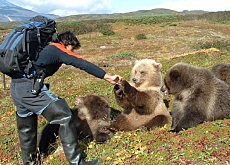
Swapping Swiss cows for grizzly bears

Swiss wildlife guide, environmentalist and photographer Reno Sommerhalder has been living a love affair with bears for nearly 20 years.
His move from the Alps to the Canadian Rockies marked the beginning of this relationship that has taken him from the Andes to the Russian Far East.
On a recent visit to Switzerland, Sommerhalder talked about his experiences in Russia’s remote Kamchatka region, where he acted as foster parent to five orphaned cubs, proving that humans and grizzlies can live peaceably together.
Originally from Zurich, the environmentalist is permanently based in Alberta, where he is president of the Banff Environmental Action and Research (BEAR) Society, and owner of a guide and consultancy service.
The 39-year-old nature lover told swissinfo that his interest in bears could be traced back to a particularly memorable experience during his early days in Canada.
Face to face
“I was hiking in the Rockies and I had a small Swiss cow bell attached to my pack, which during the night I hung up in my tent. One night, I was woken up by the bell ringing.
“When I sat up, I was staring into the face of a bear that had torn open the side of my tent.”
Sommerhalder admits that by storing food in his tent he had broken one of the cardinal rules of personal safety when hiking in bear country. But in those early days he didn’t know any better.
“Both the bear and I were shocked when we looked at each other for a second or two. Then he pulled out his head and departed.
It was as if this bear came knocking on my door telling me that there was more to life than cooking, which I still passionately do to this day. From there things progressed rather spontaneously and quite quickly my path changed.”
The former chef began travelling the world, studying and photographing polar bears in northern Canada, spectacled bears in Peru and various subspecies of black and brown bear throughout North America.
Sommerhalder has spent the past two summers on the Kamchatka peninsula, guiding bear viewing trips and working on the filming of the book Grizzly Heart by fellow bear specialist Charlie Russell.
Around 10,000 brown bears live on the economically depressed region. Even in protected areas, such as the Russian equivalent of national parks, the bears are at risk from poachers seeking to make money from the lucrative trade in the animals.
Foster father
In summer 2004 he and Russell embarked on a project to rehabilitate five cubs whose mothers had been killed by poachers. Over a period of months they gained the animals’ confidence and helped them learn survival skills.
For Sommerhalder it was also a learning experience.
“I learned so much from these little bears in this short summer,” he said. “For example, that much more of what bears do and know is instinctive rather than learned from their mothers.”
“Our main job was to protect the cubs from larger and potentially predatory male bears and to teach them how to catch salmon. Almost all of the rest was instinctual.”
Sommerhalder says that apart from the fact that bears are beautiful and intelligent, they are worth also studying because of what we can learn from them about our environment.
“I believe that we humans are currently dealing with some pretty extreme problems, such as global warming and the constant loss of natural habitat through development,” he told swissinfo.
According to the environmentalist, education is a crucial component in the struggle to save our planet and the creatures that live on it.
“Because grizzly bears are such sensitive animals that quickly respond to negative changes in their environment and because the bear is an attractive mammal to most people, they become the perfect tool for education about environmental awareness.”
swissinfo, Morven McLean
Brown bears are distinguished by their shoulder hump.
The brown bear is native to North America, Europe, Japan and North Asia.
The grizzly is one of the best-known species of brown bear.
There are 18 known subspecies of black bear throughout North America.
Black bears are not all black, and can be brown or even white.

In compliance with the JTI standards
More: SWI swissinfo.ch certified by the Journalism Trust Initiative















![The four-metre-long painting "Sonntag der Bergbauern" [Sunday of the Mountain Farmers, 1923-24/26] had to be removed by a crane from the German Chancellery in Berlin for the exhibition in Bern.](https://www.swissinfo.ch/content/wp-content/uploads/sites/13/2025/12/01_Pressebild_KirchnerxKirchner.jpg?ver=a45b19f3)













You can find an overview of ongoing debates with our journalists here . Please join us!
If you want to start a conversation about a topic raised in this article or want to report factual errors, email us at english@swissinfo.ch.